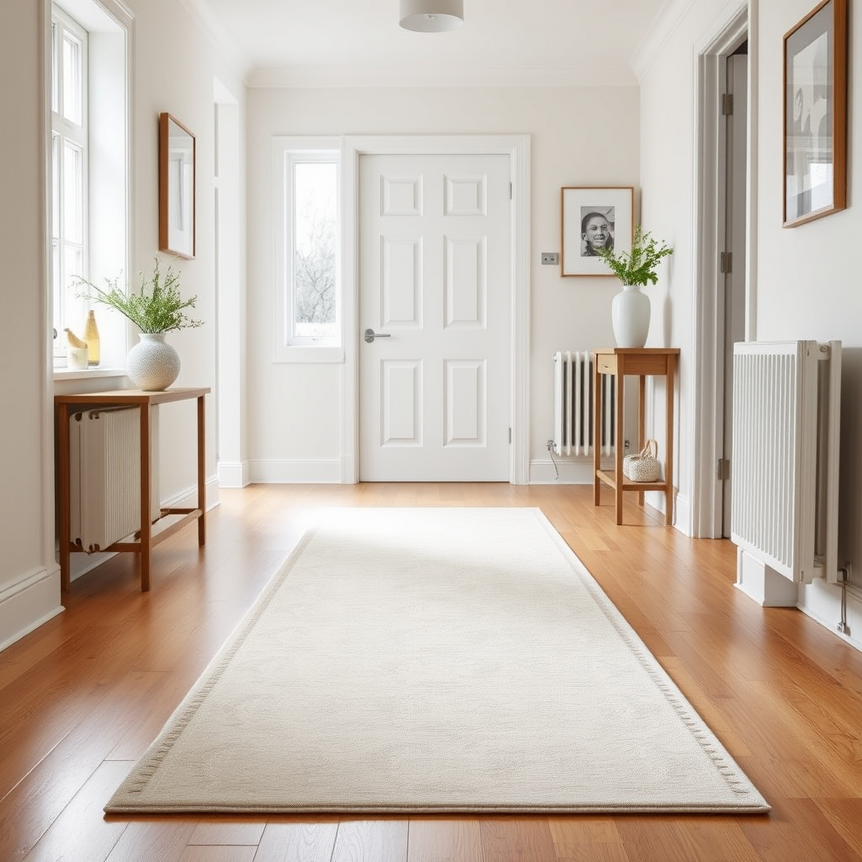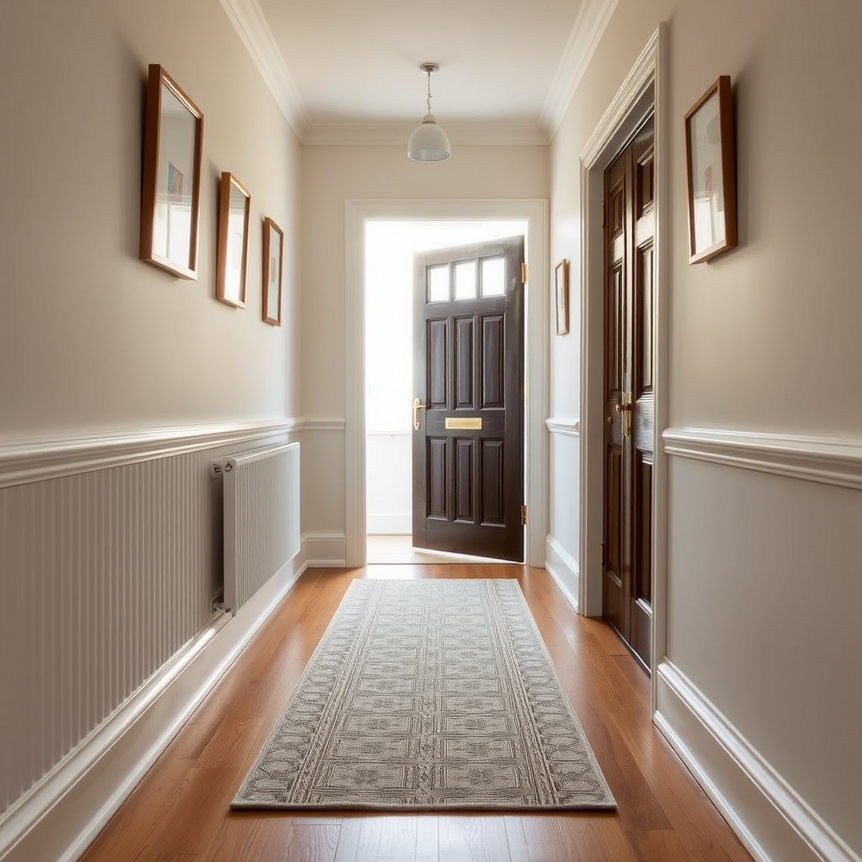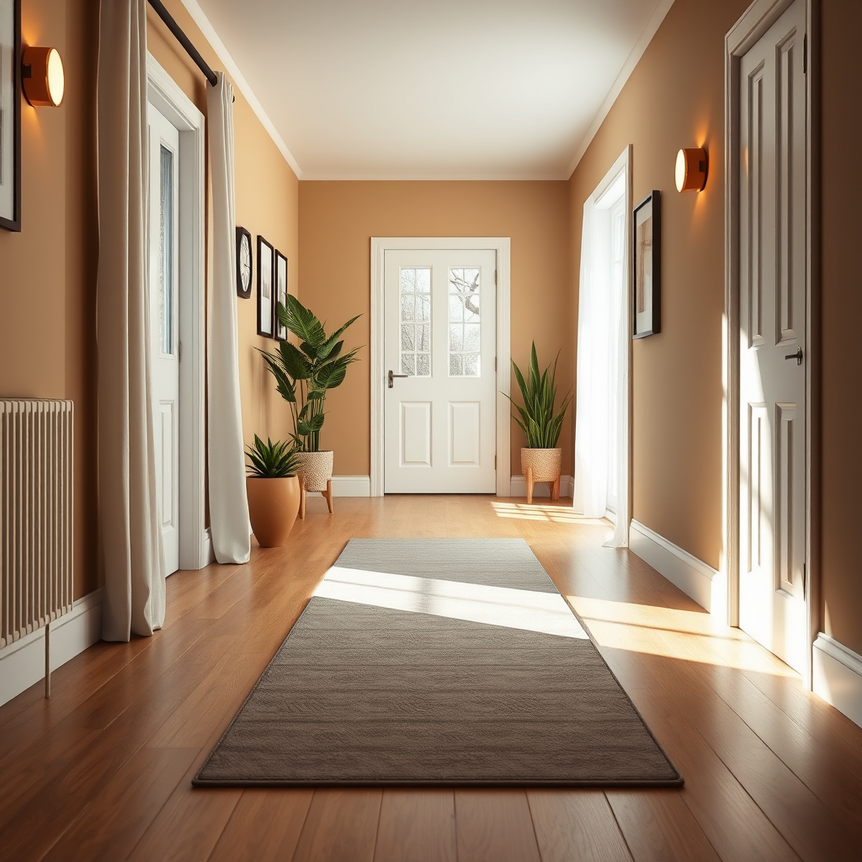Choosing the perfect hallway runner size is key to enhancing your home’s style while ensuring safety and comfort in this typically high-traffic area. Whether you have a narrow corridor or a wide passage, understanding the right dimensions will help you find a hallway runner that fits beautifully, functions well, and complements your decor. In this comprehensive guide, we’ll explore standard sizes, how to accurately measure for the right width and length, and UK-specific considerations to help you pick the ideal hallway runner for your unique space.
Standard Hallway Runner Dimensions: Finding the Most Common Sizes
Hallway runners in the UK usually come in standard widths ranging from 24 to 36 inches (approximately 60 to 90 cm), with 27 inches (about 69 cm) being a particularly popular and versatile choice. This width strikes a perfect balance between providing adequate coverage and leaving an appropriate margin of visible floor on each side of the hallway.
Lengths commonly vary from 6 to 12 feet (about 1.8 to 3.6 metres), with many runners available in fixed lengths like 8 or 12 feet. These sizes suit typical hallways but runners can also come in much longer lengths—up to 50 feet—ideal for extended corridors found in larger homes or commercial spaces.
Why is 27 Inches a Popular Width?
The 27-inch width for a hallway runner is frequently selected for its exceptional versatility and aesthetic appeal in typical UK homes. Hallways in the UK commonly range around 36 to 39 inches wide. Opting for a 27-inch wide runner allows for approximately 5 inches (about 12 cm) of floor to remain visible on each side of the rug. This margin creates a balanced look, preventing the hallway from feeling cramped and ensuring the runner integrates seamlessly into the space without becoming a tripping hazard.
Width: Leaving the Right Balance for a Perfect Fit
To determine the ideal hallway runner width, begin by accurately measuring the total width of your hallway from wall to wall. Then, subtract 8 to 12 inches (20-30 cm) from this measurement. This calculation ensures you leave approximately 4 to 6 inches (10-15 cm) of clear, visible floor space on each side of the runner. This strategic margin offers several key benefits:
- It maintains an open, aesthetically pleasing, and balanced appearance in your hallway.
- It significantly reduces the risk of the runner becoming a tripping hazard by allowing sufficient clearance.
- It facilitates easier cleaning and promotes better ventilation around the rug edges, contributing to its longevity.
Examples of Hallway Runner Width by Hallway Size
| Hallway Width | Recommended Runner Width | Approx. Margin on Each Side | Key Considerations |
|---|---|---|---|
| Narrow Hallway (e.g., 30 inches wide) | 18-22 inches (45-56 cm) | 4-6 inches (10-15 cm) | A 24-inch runner might be too wide; sizing down is crucial for safe clearance and preventing a cramped feel. |
| Standard Hallway (e.g., 36 inches wide) | 27 inches (69 cm) | ~4.5 inches (~11.5 cm) | An ideal and common choice for most UK homes, offering balanced aesthetics. |
| Wider Hallway (e.g., 42 inches or more) | 30-36 inches (76-90 cm) | ~6 inches (~15 cm) | Allows for a grander, more luxurious look and provides enhanced floor protection and comfort underfoot. |
If your hallway width falls between standard runner sizes, it’s often more practical and economical to size down. This approach helps avoid the higher cost of custom options, unless a precise, bespoke fit is a high priority for your interior design.
Length: Choosing a Runner That Complements Your Hallway
The length of your hallway runner is just as critical as its width in achieving a harmonious and functional space. Most hallways typically range between 6 to 12 feet, and the availability of runners in standard lengths reflects this common range.
- For shorter hallways (approximately 6-8 feet in length), selecting an 8-foot runner often provides excellent coverage. It neatly spans most of the length, leaving a small, aesthetically pleasing exposed floor space at each end, which contributes to a clean and functional look.
- For longer hallways (approximately 10-12 feet or more), a 12-foot runner is generally the standard choice. This length can sometimes create a slight overhang at one end, which can be used to stylishly extend the visual flow into an adjoining room.
- For extra-long hallways or corridors, custom-length runners are an excellent solution. Many suppliers offer runners that come on large rolls, allowing them to be cut to specific lengths, even up to 50 feet or more. This ensures a seamless, continuous rug that perfectly matches the precise dimensions of your extended space.
Customization and Trimming Options
Many reputable UK suppliers, including Rugstars, offer high-quality hallway runners on rolls. This provides the significant advantage of allowing you to order custom lengths that can be perfectly tailored to match the exact dimensions of your hallway. Furthermore, if you happen to acquire a runner that is slightly longer than what your space requires, professional trimming is often a viable option. This flexibility offers practical solutions for hallways with unusual or non-standard dimensions, ensuring a perfect, tailored fit every time.
Custom Sizes and UK-Specific Considerations: Tailoring to Your Space
UK homes often feature unique architectural characteristics, including hallways that can be narrower, wider, or longer than typical standard dimensions found elsewhere. This frequently makes custom or bespoke runner options a highly popular and practical choice for homeowners in the United Kingdom.
- For Narrower Hallways: If your hallway is particularly narrow, measuring carefully is paramount. You should seek out runners that are less than 24 inches wide to ensure adequate clearance on both sides, which is essential for safety and an unencumbered feel.
- For Unusually Long Hallways: Opting for custom lengths, readily available up to 50 feet or even more from specialist suppliers, is highly recommended. This prevents unsightly gaps or the need for multiple runners, which can interrupt the visual flow and cohesiveness of your long corridor.
- Supplier Capabilities: Many UK-based suppliers excel in providing runners on rolls, offering the unparalleled convenience of bespoke lengths. This combines the practical benefit of a custom fit with access to a wide array of contemporary styles and high-quality materials, perfectly suiting diverse home aesthetics.
Investing in custom sizing guarantees that your chosen hallway runner will fit your specific space like a glove, without any compromise on either functionality or aesthetic appeal. It ensures a seamless, tailored look that enhances the overall design of your home.
Placement Tips: How to Position Your Hallway Runner for Maximum Impact
Beyond simply choosing the correct size, the strategic placement of your hallway runner is absolutely essential for maximising its visual impact, enhancing safety, and optimising functionality. Consider the following key placement tips:
- Measure Furniture and Door Swings: Before positioning, carefully measure any nearby furniture and, crucially, observe the swing path of all doors opening into or within the hallway. Ensure the runner does not obstruct any movement.
- Allow Door Clearance: Leave ample space at doorways to ensure that doors can open freely without catching or dragging on the edge of the runner. A rug that impedes door function can be a significant annoyance and cause premature wear.
- Consider Traffic Flow: Strategically place runners in areas of highest foot traffic. This not only protects your underlying flooring from wear and tear but also provides a comfortable and non-slip surface, significantly enhancing safety in busy thoroughfares.
- Central Alignment: For the most balanced and aesthetically pleasing appearance, align the runner centrally within the width of your hallway. This ensures even clearance on both sides, creating a sense of order and symmetry.
A well-placed hallway runner has the transformative power to turn a utilitarian and often overlooked hallway into a welcoming, styled, and integral passage within your home.
Material and Style Trends for 2025: Selecting Runners That Match Your Hallway
The choice of material for your hallway runner significantly impacts its durability, feel, and overall performance, especially in a high-traffic area. Style trends in 2025 also offer exciting options for enhancing your home’s aesthetic:
- Material Durability: Wool and synthetic blends (such as polypropylene or nylon) continue to be highly popular choices due to their exceptional durability, resilience to wear, and relative ease of cleaning. These materials are well-suited for the demanding conditions of a hallway.
- Non-Slip Backing: For safety in bustling homes, a runner with a built-in non-slip backing is increasingly favoured. Alternatively, a high-quality rug pad placed underneath can provide excellent grip and prevent slips and bunching.
- Pile Height Considerations: Thicker, plush runners offer superior comfort underfoot and can add a luxurious feel. However, it’s vital to consider door clearance, as a high pile can obstruct door swings. Lower pile runners are often more practical for areas with frequent door movement.
- 2025 Style Trends: Wider runners, spanning up to 3 feet (90 cm) or even more, are trending significantly in 2025. These wider dimensions offer a modern aesthetic, provide enhanced coverage, and contribute to a grander feel, particularly in more spacious hallways or open-plan living areas.
Selecting a material that is perfectly suited to your hallway’s specific traffic levels and maintenance needs, combined with a style that complements your personal décor preferences, will ensure both longevity and sustained visual appeal for your chosen hallway runner.
Frequently Asked Questions
What width of hallway runner is best for narrow hallways?
For hallways that are under 30 inches (76 cm) wide, it is best to choose a runner between 18-22 inches (45-56 cm) wide. This ensures you maintain adequate clearance on each side, preventing the space from feeling cramped and reducing tripping hazards.
Can I trim a hallway runner to fit my space?
Yes, many types of hallway runners, especially those supplied on rolls, can be professionally trimmed to a precise length to fit your space perfectly. This is a common and convenient solution offered by many UK rug suppliers.
How do UK hallway measurements affect runner sizing?
UK hallways often feature varied and sometimes non-standard dimensions compared to other regions. It is crucial to measure your specific hallway width and length meticulously. Be prepared to consider custom sizing or carefully select from standard options if a precise fit is desired, as standard sizes may not always align perfectly with UK architectural norms.
Are wider hallway runners trending in 2025?
Yes, wider hallway runners, typically up to 36 inches (90 cm) or more, are increasingly popular in 2025. They are especially favoured in open or wider hallways as they enhance the aesthetic appeal, provide more coverage, and contribute to a more luxurious and expansive feel.
What is the ideal runner length for a 10-foot hallway?
For a 10-foot (approx. 3-metre) hallway, an 8 to 12-foot (approx. 2.4-3.6-metre) runner works well. Choose a 12-foot runner if you prefer maximum coverage with a slight overhang for a seamless look. Alternatively, an 8-foot runner will leave some visible floor space at both ends, offering a neat and functional appearance.
Conclusion: Finding the Ideal Hallway Runner Size for Most Hallways
For most UK homes, a hallway runner between 24 and 36 inches wide (60-90 cm)—with 27 inches (69 cm) often considered an ideal and common choice—provides an excellent fit. This allows for a comfortable 4 to 6-inch (10-15 cm) margin of clear floor space on each side, which is essential for maintaining balance, ensuring safety, and enhancing aesthetic appeal. Lengths typically ranging between 6 and 12 feet (1.8-3.6 metres) are suitable for covering most standard hallway dimensions.
However, for longer or unusually shaped hallways, custom options are widely available, especially through UK suppliers who offer runners on rolls that can be cut to precise lengths. Always measure your hallway accurately, carefully consider factors like foot traffic flow, door swings, and existing furniture placement. Furthermore, selecting high-quality materials and styles that align with your home’s aesthetic will ensure your chosen hallway runner not only elevates your home’s look but also significantly enhances functional comfort and overall safety.
Explore our extensive selection of non-slip hallway runner rugs and discover bespoke sizing options at Rugstars to find the perfect fit and style for your home today.



